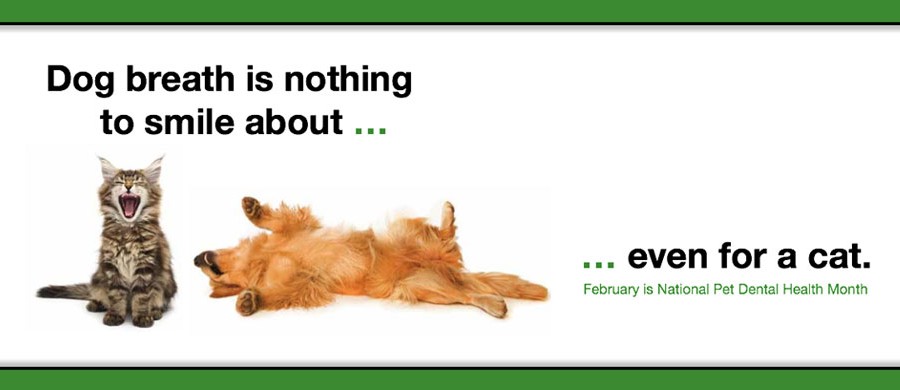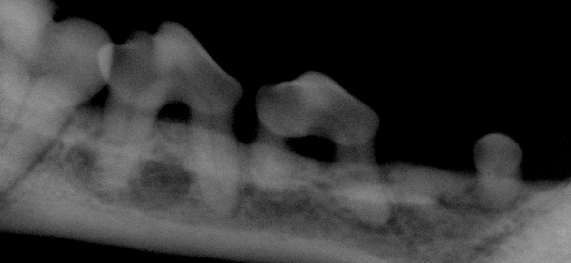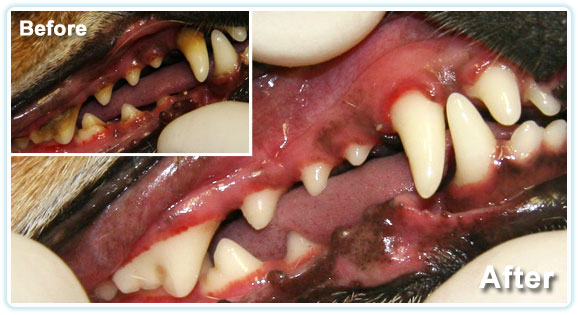|

<
February is Pet Dental Health Month, a nationwide campaign to bring attention to the most common disease afflicting our four-legged family members, Periodontal Disease. Periodontal disease in dogs and cats is the most prevalent, and oftentimes most overlooked, health problem that they have. It is far more common than heartworm disease, diabetes, hip dysplasia and even skin and ear problems. 80 % of dogs and 70 % of cats have periodontal disease that can lead to bone loss which causes chronic pain. This statistic means that over 8 of every 10 dogs and 7 of every 10 cats are going through their lives with pain that is very hard for their humans to detect. In addition to pain, dental disease also leads to other health problems as the bacteria can cause damage to the kidneys, liver, lungs and even heart. The mouth is truly the gateway to rest of the body and pets with healthy mouths live on average 2 years longer than pets with unhealthy mouths. Owners will often complain of their pet’s bad breath but have no idea that the foul odor is a signal that their beloved four legged family member has mouth pain. These pets continue to eat and go about their normal activities, perhaps just sleeping more, which most people just chalk up to getting older.
Brandywine Hospital for Pets promoting pet dental month and encouraging pet owners to have their pet’s mouths cared for. An Oral ATP (oftentimes called a “Dental”) is a lot more than just having your pet’s teeth cleaned. It is a very thorough ASSESSMENT of your pet’s mouth including X-rays of all your pet’s teeth. Dental X-rays are a relatively new diagnostic tool that is invaluable to finding and treating painful teeth. We have invested in digital dental X-rays (Dental Radiography) and have found it to be incredibly helpful for pet’s who were experiencing symptoms, (sometimes very subtle) including hiding, reluctance to allow anyone to touch their face, chattering jaws, swollen lymph nodes, facial swelling, increased sleeping and decreased appetite. Owners are always surprised to see the X-rays of abscessed tooth roots or fractured roots that can’t be seen because it is below the gum line.

Severe bone loss in advanced Periodontal Disease.
During an Oral ATP, after the teeth are X-rayed, we carefully probe each tooth like the dental hygienist does when you have your teeth cleaned. The next step in an Oral ATP is TREATMENT, which is the ultrasonic and hand scaling (commonly called cleaning) of the teeth which includes the part of the tooth you can see and more importantly the part of the tooth below the gum-line where the bacteria live.

While the teeth look better, a thorough scaling (cleaning) always includes getting under the gums to where the real problems lie.
Bacteria are the enemy of teeth, causing bad breath but also causing bone loss that leads to abscessed, loose, diseased and painful teeth. Once the teeth are cleaned, they are polished making them smooth so bacteria have a harder time sticking to the surface and we are finally ready for the last step, PREVENTION.
Prevention at home is important and we design an individualized approach to home care for each pet. Brushing your pet’s teeth at least 3 times a week is ideal but sometimes unrealistic due to the nature of the pet or the time constraints under which many of us struggle. So we often times make due with a special mouth rinse that is safe for pets if they swallow it and/or chews that are formulated to kill bacteria in the mouth.
It is important to understand that all Oral ATPs are done under general anesthesia because we need to have the pet completely still to do a thorough, effective job. It would be easier if we could get them to sit back in a dentist chair and say “Ahhh” but that just doesn’t happen. At Brandywine Hospital for Pets, we take every precaution to ensure safe anesthesia and we have invested in state-of-the-art technology to monitor their heart beat, blood pressure, oxygen saturation, body temperature and respirations. We individualize recommendations for lab work before any anesthesia based on the patient’s age and health. Our anesthetic protocols are then individualized for each patient to address any pre-existing conditions. The fear of general anesthesia should not be a deterrent from having your pet’s teeth cared for; it is much safer than allowing a disease to run rampant in your pet’s mouth. With modern anesthetic drugs and monitoring the benefits of an Oral ATP and proper dental disease treatment far outweighs the risks of general anesthesia.
Call us day to schedule your appointment!
|
